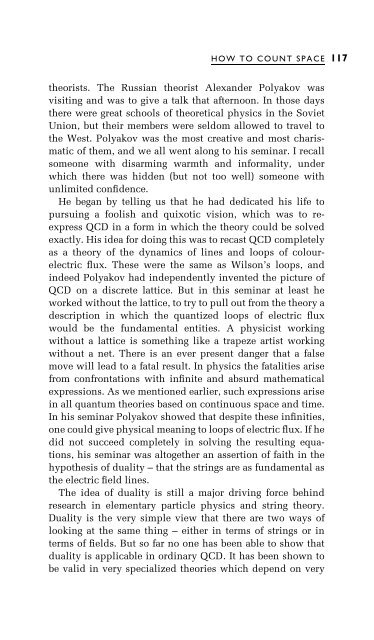Three Roads To Quantum Gravity
Three Roads To Quantum Gravity
Three Roads To Quantum Gravity
You also want an ePaper? Increase the reach of your titles
YUMPU automatically turns print PDFs into web optimized ePapers that Google loves.
HOW TO COUNT SPACE<br />
117<br />
theorists. The Russian theorist Alexander Polyakov was<br />
visiting and was to give a talk that afternoon. In those days<br />
there were great schools of theoretical physics in the Soviet<br />
Union, but their members were seldom allowed to travel to<br />
the West. Polyakov was the most creative and most charismatic<br />
of them, and we all went along to his seminar. I recall<br />
someone with disarming warmth and informality, under<br />
which there was hidden (but not too well) someone with<br />
unlimited con®dence.<br />
He began by telling us that he had dedicated his life to<br />
pursuing a foolish and quixotic vision, which was to reexpress<br />
QCD in a form in which the theory could be solved<br />
exactly. His idea for doing this was to recast QCD completely<br />
as a theory of the dynamics of lines and loops of colourelectric<br />
¯ux. These were the same as Wilson's loops, and<br />
indeed Polyakov had independently invented the picture of<br />
QCD on a discrete lattice. But in this seminar at least he<br />
worked without the lattice, to try to pull out from the theory a<br />
description in which the quantized loops of electric ¯ux<br />
would be the fundamental entities. A physicist working<br />
without a lattice is something like a trapeze artist working<br />
without a net. There is an ever present danger that a false<br />
move will lead to a fatal result. In physics the fatalities arise<br />
from confrontations with in®nite and absurd mathematical<br />
expressions. As we mentioned earlier, such expressions arise<br />
in all quantum theories based on continuous space and time.<br />
In his seminar Polyakov showed that despite these in®nities,<br />
one could give physical meaning to loops of electric ¯ux. If he<br />
did not succeed completely in solving the resulting equations,<br />
his seminar was altogether an assertion of faith in the<br />
hypothesis of duality ± that the strings are as fundamental as<br />
the electric ®eld lines.<br />
The idea of duality is still a major driving force behind<br />
research in elementary particle physics and string theory.<br />
Duality is the very simple view that there are two ways of<br />
looking at the same thing ± either in terms of strings or in<br />
terms of ®elds. But so far no one has been able to show that<br />
duality is applicable in ordinary QCD. It has been shown to<br />
be valid in very specialized theories which depend on very



![arXiv:1001.0993v1 [hep-ph] 6 Jan 2010](https://img.yumpu.com/51282177/1/190x245/arxiv10010993v1-hep-ph-6-jan-2010.jpg?quality=85)


![arXiv:1008.3907v2 [astro-ph.CO] 1 Nov 2011](https://img.yumpu.com/48909562/1/190x245/arxiv10083907v2-astro-phco-1-nov-2011.jpg?quality=85)








![arXiv:1002.4928v1 [gr-qc] 26 Feb 2010](https://img.yumpu.com/41209516/1/190x245/arxiv10024928v1-gr-qc-26-feb-2010.jpg?quality=85)
![arXiv:1206.2653v1 [astro-ph.CO] 12 Jun 2012](https://img.yumpu.com/39510078/1/190x245/arxiv12062653v1-astro-phco-12-jun-2012.jpg?quality=85)
